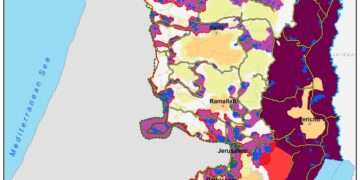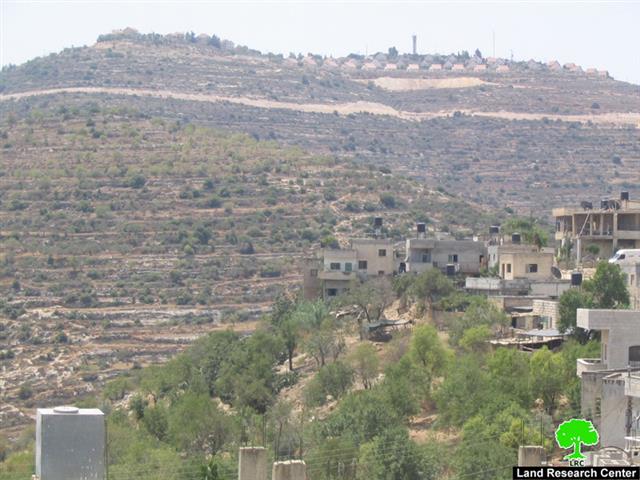The administration of the so-called College of Judea and Samaria, located in the colony of Ariel in the Governorate of Salfit, has declared its intention to upgrade the college into a “University Center” starting on the beginning of August, 2007. The occupation government has supported such a transformation under the pretext that the move “would assist in enlarging the base of higher education in Israel as to benefit the Israeli society and economy.”
The ex-Israeli Prime Minister, Ariel Sharon, had approved such a step in May 2005 in a political, rather than an academic, step as it came in reaction to the British academic decision of boycotting 2 Israeli universities (Bar Illan and Haifa) in their capacity of supervising the College in Ariel.
( Photo 1: Ariel colony surrounded by the segregation fence )
Incentives and Rewards:
Israeli occupation authorities have taken the step of transforming the college into a university in the framework of enhancing and supporting the position of colonial groupings in the West Bank especially after the Gaza pullout in 2005. These authorities have carried out a policy of encouraging Israelis to move into colonies in the occupied West Bank including direct economic incentives for the colonists and the Jewish local authorities in the Occupied Territory. It is worth noting here that Israeli colonies in the West Bank are usually classified into Development Areas A or B which allows the investors in these areas to get economic incentives and tax exemptions from the following ministries:
-
The Ministry of Housing (large loans for apartment buyers with part of the loans turning into gifts);
-
The Ministry of Education (non-payment of kindergarten fees as well as incentives for the teachers including free travel oversees);
-
The Ministry of Industry and Commerce (basic infrastructure for industrial zones as well as financial rewards);
-
The Ministry of Labor and Welfare (incentives for the social workers);
-
Ministry of Finance (financial reductions on personal and company income taxes as well as tax exemptions).
-
State Land Authority (large reductions on land yearly rental fees).
The funneling of monies to the colonists in the occupied Palestinian territory usually takes place through the Colony Department in the World Zionist Organization (WZO). It is considered to be one of the main tools used by the WZO to support colonial local councils (vs. its treatment to the local councils inside the Green Line).
The Colony of Ariel:
The colony of Ariel is considered to be one of the largest colonies in the West Bank. Israeli occupation authorities call it the capital of Samaria. It was established in 1978 in the Governorate of Salfit on the eve of the signing of the Camp David Accords between Israel and Egypt. The colony’s initial area was 500 dunums of the lands of the village of Marda and the city of Salfit. The area of the colony began expanding soon after its establishment to be currently composed of 13,775 dunums of which 2,479 (from the villages and towns of Marda, Kifl Haris, Iskaka and Salfit) are used for colonial housing purposes. The colony was transformed into a city during the rein of power of the ex-Israeli Prime Minister Benjamin Netanyahu. It contained the so- called College of Judea and Samaria as well as a number of different factories, hotels and a large number of colonial housing units. According to the Foundation for Middle East Peace, the number of colonists living in the colony in 2005 was 16,520. The current Municipal boundaries of the colony are at least four times its current built-up area which makes it viable for additional future expansion in order to house more colonists.
(Map 1: Location of Ariel colony and Salfit city)
In addition to what is listed above, the colony of Ariel is the third largest colony in the West Bank in terms of surface area and population after Ma’ale Adumim and Pisgat Ze’ev in the outskirts of Jerusalem. In the year 1999 Israeli occupation forces confiscated large plots of the lands of the villages of Haris and Bruqin west of the governorate of Salfit for the benefit of the colony. An industrial zone (known as Ariel Gardens) was built atop the confiscated lands. It currently has 4 main factories including oil as well as plastic factories.
( Photo2 + 3: Some factories in Ariel colony passed by the Trans Samaria bypass road number 5)
Impact of the Colony of Ariel on Palestinians in Salfit Governorate:
-
It has become a frequent occurring that colonists of Ariel release large numbers of wild pigs into Palestinian lands. In addition to the financial damages caused by the pigs to Palestinian crops, psychological problems (stemming from fear) has been recorded between the children and the elderly in the area as these pigs usually attack everyone that gets near them. So far, there were 4 reported cases in which children sustained critical wounds due to pig attacks in the region.
-
Ariel colonists usually take advantage of the rainy season to mix their sewage with the rain water headed towards Al Matwi well located west of the city of Salfit. This has led to the pollution of the well and the spread of diseases (especially during the years 2005-2006) in the city of Salfit and its immediate environs given the fact that this well covers 50% of the water needs of the city of Salfit and its associated villages.
-
The polluted water and the by-products of the Israeli factories in Salfit governorate (especially those in the colony of Barkan and the industrial zone in Ariel) are considered to be a source of threat for humans, wild animals and the environment due to its highly toxic content. Moreover, these by-products are attracting rodents and flies while producing awful odors. Wadi Qana, which is located north of the governorate, is the best example of the impact of these by-products on the environment.
Prepared by

















